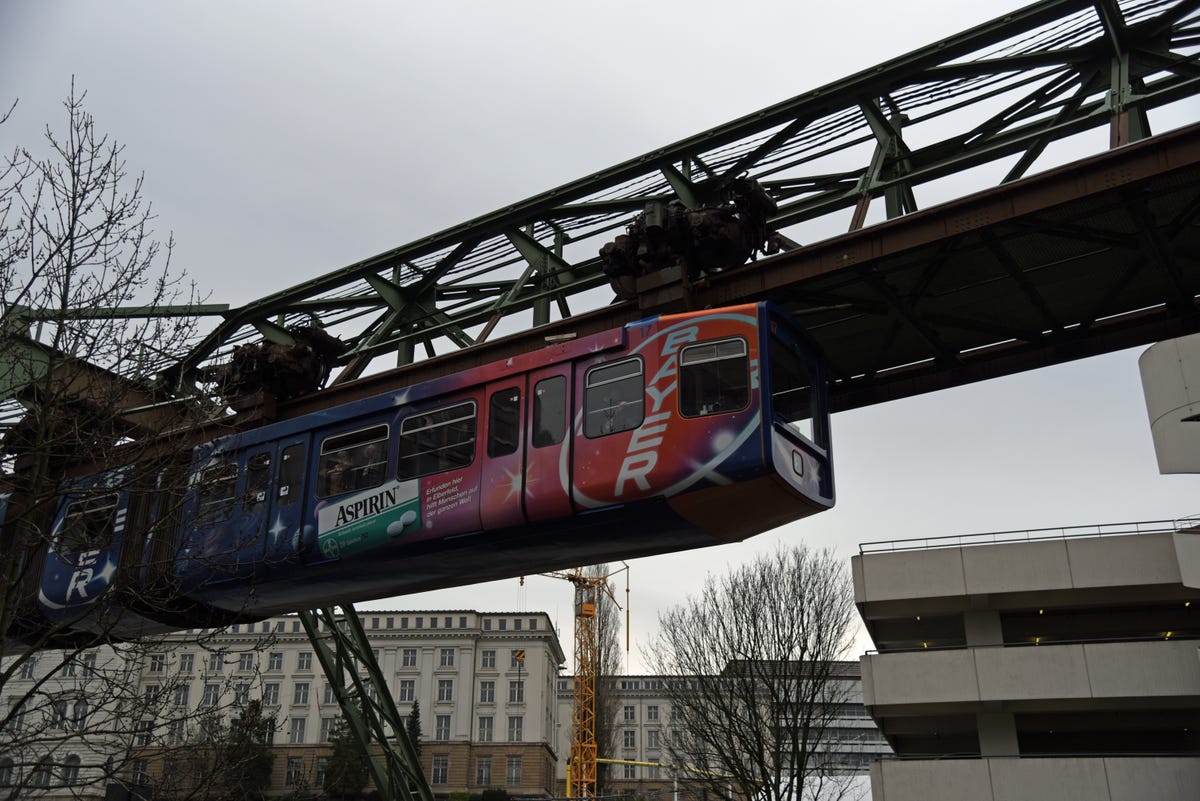Riding the king of monorails (pictures)
The Wuppertal Suspension Railway in Germany is an industrial-age masterpiece and the oldest monorail still in service. CNET goes for a ride.

In between visiting the Christmas markets of Cologne, Germany, last weekend I dragged my husband on a railway adventure I've wanted to take for years. About 40 miles north of Cologne and 20 miles east of Düsseldorf is the industrial city of Wuppertal and its star attraction, the Wuppertal Schwebebahn, or the Wuppertal Suspension Railway. First envisioned as a possible transit system for Berlin, construction began in 1898 with the first section opening relatively quickly in 1901.
Long before Disneyland and The Simpsons made monorails mainstream, it was an engineering marvel of its time. And as the oldest monorail still in service, it's just as incredible today.
Though now almost 115 years old, it remains an important public transit link for Wuppertal, carrying 80,000 passengers per day. As the city follows a narrow river valley with steep hills on both sides, the single line railway runs 8.2 miles, connecting both ends of town to the central train station (Hauptbahnhof). Here's a train just after departing the Hauptbahnhof.
We started our ride in the Vohwinkel station at the line's western end, where trains idle for a few minutes before starting on another journey. Trains hang from the single rail on four supports, each with four wheels. The current one-way fare is €2.50 (about $2.75, £1.80 or AU$3.80).
New trains are being introduced this year, but most of the 25 trains currently in service were completed in the early 1970s. Each two-car train is 79 feet (24 meters) long and articulated in the center. Total passenger capacity is 199, with 43 seats.
The first two miles of the route runs directly above city streets. The tracks are supported by 464 frames that dominate the cityscape. It's a heavy, very industrial-age effect that's not unlike Chicago's "L." You may call it unsightly: I call it amazing.
Sit in the front for a great driver's-eye view of the route. The train passing on the left is painted in the original 1901 color scheme. On special occasions the line runs one of the original trains for passenger trips. Called the "Kaiserwagen" for German Emperor Kaiser Wilhelm II, who rode the railway before it opened to the public, it's also available for private parties.
After leaving the city streets the line runs 40 feet (12 meters) above the Wupper River for 6.2 miles. This section was first part of the line to open on March 1, 1901. The second section down to the Vohwinkel station opened three weeks later on March 24.
It was on the river section that the Schwebebahn's only fatal accident occurred on April 12, 1999. The first train of the morning hit a metal claw on the track that workers had not removed after nightly maintenance. The train derailed and fell into the river killing five people and injuring 47. In the most recent accident, a train collided with a crane truck parked on the street below. Several passengers and the truck driver were injured.
Stations along this section also stretch over the river. The average distance between each of the 20 stations is 2,000 feet (700 meters).
Sitting in the back also provides a great view. As you bend around curves -- and there are quite a few as you're following a river -- the train noticeably sways. It's almost like riding a roller coaster. The maximum speed of the trains is 37 miles per hour but you're more likely to travel at about 17 mph.
Along the route trains pass over a major motorway, city streets, busy intersections, a long-distance railroad, and utilities and water pipes between the factories that line either side of the river.
The Oberbarmen station at the other end of the line is on the last section of the Schwebebahn, which opened on June 27, 1903. Like on the London Underground, it's important to mind the gap between the train and the platform.
After passengers disembark at Oberbarmen, trains enter the storage depot and turning track. As trains have driving cabs only at one end, they must change direction before they can make the return journey to Vohwinkel.
Both ends of the same train poking out of the depot's portals makes for a peculiar sight.
Here's a close-up of one of the "bogies" that connect the train to the single rail. Electric motors running on 600 volts drive each train.
After taking on new passengers our train begins a new journey. During peak times, 18 trains are in service.
Station design differs along the route. Some are simple and utilitarian like you can see here.
Others have been redesigned with glass walls and a few have been restored to their original 1901 appearance.
As the railway hangs from the track, all stations have a metal grating beneath where the trains stop, to prevent you from falling through.
Like many buses and railcars in cities around the world, many of the Schwebebahn's trains are rolling advertisements.
As you can see from this map of the entire route, the railway is one long line winding its way through Wuppertal.

